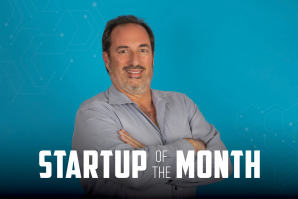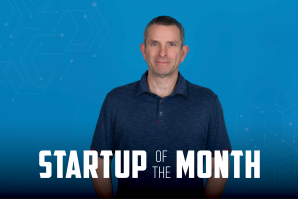On June 30, 2013, the Yarnell Hill Fire became one of the deadliest wildland fires in U.S. history. It claimed the lives of 19 elite firefighters from central Arizona. Three years later, while studying this incident in an advanced wildland command operations class, Scott Holman couldn’t believe no high-tech tool had existed to prevent a tragedy of this nature. So he created one.
Red Line Safety, his Sacramento-based startup, is enhancing firefighter safety and efficiency with wearable technology that monitors a firefighter’s location, vital signs, environmental conditions and toxic gas exposure in real time.
“Many fire incidents are still managed using radios, dry erase boards and maybe an app in the back of an SUV,” says Holman, who has 33 years of experience in the fire and EMS industry. “By integrating advanced wearable technology, we empower commanders with immediate insights … allowing for more informed decision-making and more efficient response strategies.”
In 2016, Holman asked his son, Ben, who was a computer science student at San Jose State University, if there was technology that could have helped during the Yarnell incident. He found none, so Holman sent his son $500 to build a proof of concept. A year and a half later, Holman connected with an engineering team in Santa Barbara that designed and built the hardware.
The devices use advanced sensors and mesh networking to keep firefighters connected in remote areas, while tracking exposure and physiological data to protect their health, Holman says. The hardware, he adds, can also be mounted on vehicles or set up around a fire’s perimeter to provide real-time data (temperature, pressure, humidity, CO, air quality, and wind speed and direction), which helps teams predict fire movement and make quicker decisions.
As an incident commander, Dan Baker, a retired battalion chief from Sacramento Metro Fire, often would send firefighters into “a lot of unknowns,” he says.
“I’m sending them into a very dangerous situation,” Baker says, “and the burden is on them if they get into trouble to call for help. And all they have is a radio. So if a building starts to collapse — or partially collapse—and we can’t tell from outside, we don’t know what’s happening.”
Among other benefits, such as saving taxpayer dollars and preserving public trust, he says, Red Line Safety would revolutionize the ability to identify firefighters’ locations at any given time and determine if they need immediate assistance.
Enhanced positional awareness—especially in areas with poor reception—could improve safety and resource deployment for firefighters, adds Dr. Stephen Rossiter, a cardiac surgeon and chair of the Dept. of Cardiac Surgery and Cardiology at Mercy General Hospital.
Rossiter has been associated with Metro Fire for over 20 years, teaching EMS at the Fire Academy. He often provides informal consultations to firefighters about health concerns and injuries affecting them or their families, he says. After reviewing the technical capabilities of Red Line Safety, he believes the technology shows promise.
“The devil is in the details, from who they partner with to ensuring it’s affordable for the fire department,” Rossiter says. “Even though there are potential advantages, the fire department must stay within their budget and have proof that this is valuable to them, that it will make a difference from a business standpoint.”
After bootstrapping and receiving support from friends and family, Red Line Safety secured a grant from Homeland Security through UC San Diego’s WIFIRE Program, which provides real-time fire modeling and predictions. When Red Line Safety’s technology was tested within their system, it enhanced the accuracy of weather data, Holman says. The startup is now looking to raise $1 million on Wefunder.
Holman believes the monumental task of building hardware is why this technology hasn’t been developed until now. Fire services often lack the time and tools to innovate, requiring support from outside sources. Even then, adoption presents its own challenges, he says.
Having experience in this arena, Holman felt compelled to launch this startup despite his lack of experience in the corporate world.
“Over the years, over decades, I’ve seen, heard and actually knew people who have died and gotten sick in the line of duty, and it just seemed such a massive loss of life that something had to be done,” he says. “Of course, I have no experience in corporate management or technology development, but I knew that something had to be done.”
–
Stay up to date on innovation in the Capital Region: Subscribe to the Comstock’s newsletter today!
Recommended For You

Startup of the Month: Unstructured
Company helps businesses turn raw data into AI-friendly formats
Think about a global company where each department has its own unique jargon, and employees speak different languages. To thrive, this company would need a way to keep valuable information from getting lost in translation.

Startup of the Month: 811spotter
Ticket management software for contractors’ efficiency, safety
811 is the national toll-free, call-before-you-dig number. Homeowners, excavators and contractors must call 811 before excavating to have underground utility lines marked to prevent accidental damage. But the system is flawed and inefficient, according to 811spotter co-founder and CEO Marc Krichman.

Startup of the Month: Soar Optics
Company targets microplastics in water with high-tech microscopes
Microplastics can be found everywhere, from Antarctica to Mt. Everest to breast milk. A Western Regional Winner in 2022, Soar Optics develops technology to identify these microscopic particles in water.

Startup of the Month: Inspirame
College and career navigation platform aims to repair education pipeline
In 2019, CEO Maria Medrano co-founded the equity-driven startup Inspirame to repair these critical gaps in college enrollment and workforce development.

Startup of the Month: AgriNerds
Mapping tool helps farmers track carriers of bird flu
In recent years, avian influenza (or “bird flu”) has been on a rampage, wiping out wild and domestic birds, disrupting the environment, and causing a shortage of eggs and poultry meat. The Davis-based startup AgriNerds aims to help farmers to identify potential risks and protect poultry against the threat of diseased ducks.

Startup of the Month: 3D Organic Polymer Silk
Trio of researchers aim to revolutionize orthopedic medicine with spider silk
With over 3 billion years of evolution under its belt, the natural world has a pretty long track record of creativity. Knowing this, three interdisciplinary researchers at UC Davis looked to the golden silk orb-weaver spider to develop an innovative biomaterial.



